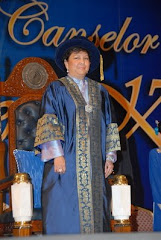PUTRAJAYA: Up to three out of 10 Malaysians who signed up to pursue
their doctorates on a part-time basis end up dropping out because of work and family commitments.
This has discouraged many others at a time the Higher Education Ministry is targeting 60,000 PhD holders by 2023, up from the present 14,000.
Professor Dr Zakaria Kasa, head of the National Council of Professors’ education and human capital development cluster, said many of those pursuing their PhDs locally often found that they did not have enough time to focus on their research because of work and family commitments.
“Others then become sceptical about taking up PhDs when they see people they know dropping out halfway,” he said.
This is the reason more people preferred to pursue their PhDs overseas, where they feel they will able to focus better on their research.
Another reason is a high dependency on scholarships or sponsorships.
“This isn’t a problem in public universities because there are allocations for staff and with the government’s MyBrains15 Scholarship programme, non-lecturers are also given an opportunity to pursue PhDs.
“Unfortunately, many want to go overseas and there are very few scholarships for this. Even atmy university, we have a quota for overseas scholar ships,” he said. Zakaria is deputy vice chancellor of Universiti Pendidikan Sultan Idris.
He said the National Council of Professors was looking at means of motivating more people to pursue PhDs.
“If possible, the council will like to see every academic become a PhD holder,” he said, adding that there was a shortage of professors, which now stood at 1,700 nationwide.
“In developing countries, academics adhere to a pyramid structure where professors are at the top, followed by associate professors and then lecturers. In developed countries, it is a reverse pyramid.” In developed countries, the number of professors reflects a university’s excellence.
“It’s not easy to be promoted to professor level.
“There are criteria that need to be fulfilled like the number of published papers.” Local universities also do not have the kind of funding compared with established universities overseas, such as Harvard, which receives generous funds from its alumni.
Zakaria said it would be an investment for the country if it could provide funding to allow those pursuing their PhDs to go to some of the top 100 universities in the world.
Yesterday, Higher Education Minister Datuk Seri Mohamed Khaled Nordin said the government had, to date, received 2,802 applications for the MyMaster, 672 for the MyPhD and 51 for the PhD Industry components of the MyBrain15 Scholarship programme.
He said this after witnessing the signing of a memorandum of agreement for an engineering doctorate programme between Universiti Teknologi Malaysia Melaka (UTeM) and several private engineering companies at the Marriott Putrajaya. Khaled had announced previously that the government was targeting to reach 650 successful applications for MyPhD, 8,000 for MyMaster and 100 for PhD Industry this year.
Under the programme, successful candidates for MyPhD, MyMaster and PhD Industry will receive RM22,000, RM10,000 and RM50,000 each respectively as long as they further their study in Malaysia.
The MyBrain15 programme aims to produce, among others, 5,000 PhD holders under the MyPhD project, 40,000 master’s degree holders under MyMaster programme and 500 PhD Industry holders, by 2015.
Read more: 3 out of 10 doctoral students drop out http://www.nst.com.my/nst/articles/3outof10doctoralstudentsdropout/Article/#ixzz1ZD7IVBeN
Subscribe to:
Post Comments (Atom)








No comments:
Post a Comment